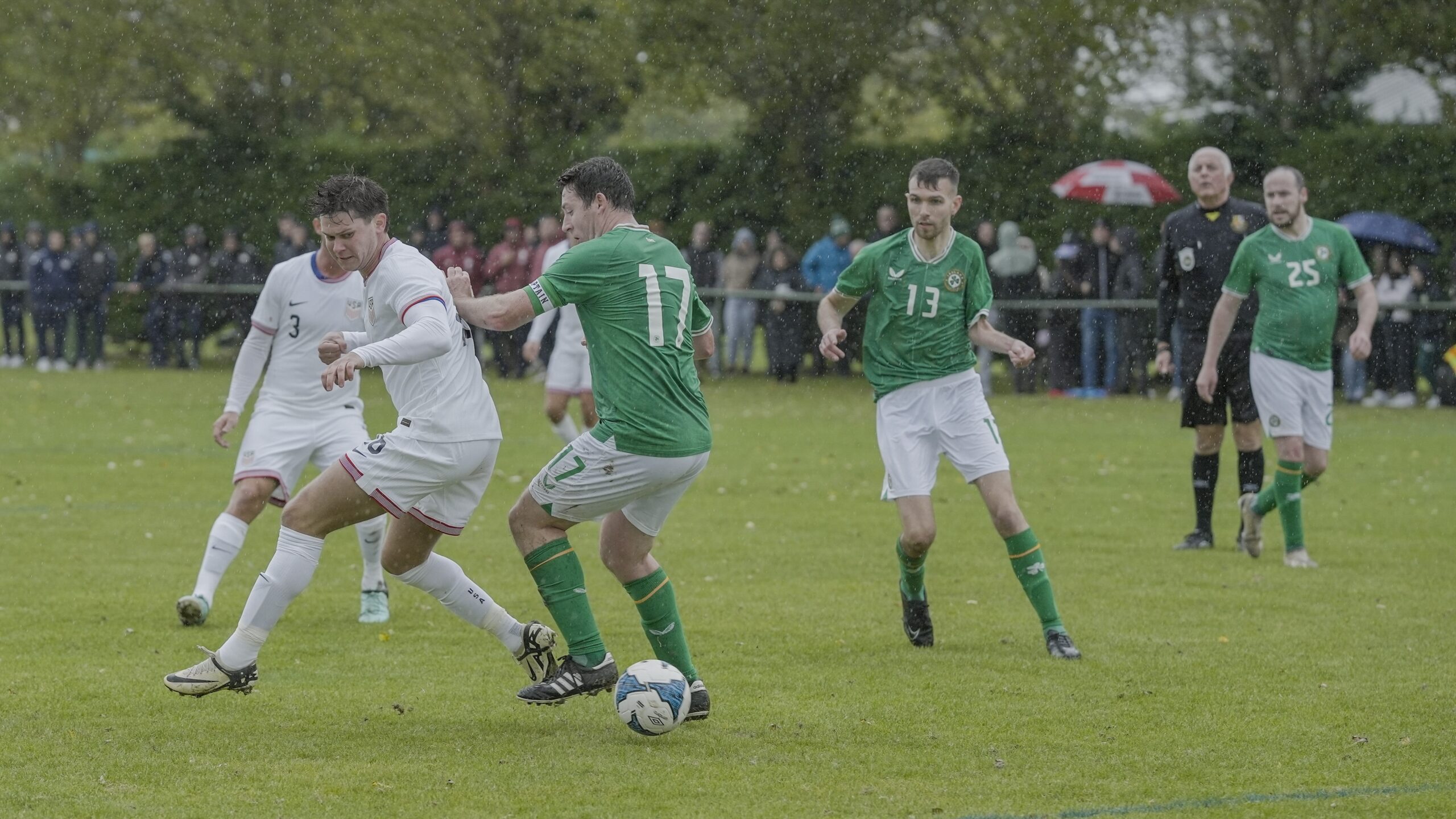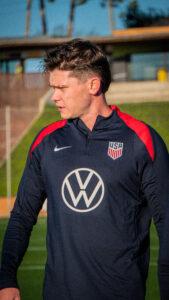Goal Getter

The Remarkable Rise of Paralympic Soccer Star Gavin Kohner
Writer Shannon Severson // Photography by Tim Berridge



Under the warm Spanish sun last November, Gavin Kohner marked his birthday in extraordinary fashion — stepping onto the field in U.S. national team colors for his Paralympic soccer debut against Australia. Just days later, the North Valley native would score his first international goal against Germany, adding another remarkable chapter to a story that began with doctors telling his parents he might never run.
Now, as he approaches graduation from Clemson University with an accounting degree, the 22-year-old Paralympic soccer standout embodies what can happen when athletic skill, relentless effort and unwavering family support converge.
As an infant, Gavin’s parents, Gena and Tim, noticed he was using only one side of his body as he learned to crawl. They also saw his incredibly determined personality. A neurologist diagnosed Gavin with cerebral palsy, a group of neurological conditions that impacts balance, movement and posture and the most common motor disability among American children. He warned the new parents that their firstborn son would never run and would struggle even to walk.
“No. He’ll run,” Gena recalls Tim telling the doctor. “I remember being in the elevator afterward, and we were both upset, but Tim said, ‘He’s going to run. He’s going to walk.’”
They decided not to accept the doctor’s prognosis.
The Kohners did everything they could for Gavin — leg and arm braces, trips to Germany for stem cell treatments and multiple surgeries. One of his surgeries at Rady Children’s Hospital-San Diego lengthened the Achilles tendon in his right leg and repositioned a calf tendon to straighten his right foot, giving him a proper heel-toe strike when walking and running. Before the surgery, he had the privilege of meeting football star Tim Tebow. It bolstered Gavin for surgical recovery and countless hours in physical therapy to regain full movement.
Gavin doesn’t remember his earliest years or his parents’ initial explanation of his diagnosis, but he recalls an early awareness that his body wasn’t doing what he wanted it to do.
“First of all, when I found out [my diagnosis], it hit me hard,” Gavin reveals. “I remember having to get braces for my leg and braces for my arms. I always knew I was a little different than the others.”
There were times when kids were cruel, and Gavin did his best to hide the hurt, knowing people were oblivious to what was affecting him. But with time, he says, he’s gotten better at accepting who he is.
Another early memory that speaks to Gavin’s innate strength of spirit is his intent to prove everyone wrong.
“Doctors would tell me, ‘You won’t be able to walk past a certain age,’ or ‘You won’t be able to do this as well as the others,’” he says. “So hearing that kind of gave me a motivation to come back the next time and say, ‘See? I did this. Now give me another task so I can prove you wrong.’
“The negativity, I guess you could call it, helped me push myself as much as I could to the best of my ability.”
Gavin began playing soccer on the elementary school playground, then joined Christ’s Church of the Valley recreational league in his hometown of Peoria and later joined the Real Salt Lake Arizona club team based in Scottsdale. He always played alongside his peers.
Though no one else in his immediate family played soccer, Gavin’s father, Tim, was a lifelong athlete with 25 years of football coaching experience in the Valley. He could see the effort his young son put into every action, always with a smile on his face.
“I coached him in figuring out how to utilize his skills,” Tim says. “Soccer was the best avenue for his leg. Over time, that same strength and determination that got him to crawl, then walk, then run, then play carried him into college and playing for the U.S. Paralympic Soccer Team. He has grit, drive and discipline.”
Tim says that being around high-performing athletes throughout his life was a good match for Gavin’s own pursuit of athleticism, and while he was proud to help his son achieve to the best of his ability, an athletic scholarship wasn’t the goal.
“Coaching is helping kids, regardless of setbacks, to work through challenges and excel,” he says. “I wanted to teach him discipline, teamwork, getting yourself back up and learning how to win and lose. Our faith is at the center of all that. Whatever the case may be, you want the best for your child. You hope you’ve prepared them for the world and hope they use their character traits to find the right path. It’s the power of prayer. I thank God that Gavin has seen the value of hard work.”
His life and health have taken twists and turns as, despite his strength and talent, he is prone to injuries that sideline him occasionally.
“I push myself,” Gavin says. “I can’t say it’s hindered me, but my muscles are tighter. I have to think about stretching more. On the field, CP can mess with my balance, so I have to be strategic about direction. My reaction time is a little slower on my right side. I definitely have to prioritize my health more than the average person, but movement is medicine. If I’m not on the field, I’m in the gym.”
Gavin has never viewed himself as “disabled,” so when a nurse at San Diego Children’s Hospital recommended that he attend a youth talent identification camp for Paralympic soccer in Chula Vista, California, he balked.
“At first, I didn’t want to be a part of it,” he recalls. “I didn’t want to be classified as disabled.”
After his eighth-grade year, Gavin decided to give it a shot. His family contacted the coach, Stuart Sharp, and submitted game footage. He was accepted and gained new perspective.
“The cool part was meeting people like me,” Gavin says. “There were people with cerebral palsy, traumatic brain injuries and strokes. Once I got there, I didn’t see them as disabled.”
Paralympic soccer has a slightly different format than standard soccer, utilizing seven instead of 11 players per side with a slightly smaller field and slightly narrower goals, but Gavin says there is no shortage of running and constant motion.
His perspective evolved further when he was invited to attend a fall camp for the men’s team, where he was the youngest attendee by 5 years.
“Some had played semi-pro ball or played in college,” Gavin recalls. “There were military veterans and people who had experienced brain injuries. Some had to relearn how to play soccer.”
Tim also saw the change in his son after these encounters and supported Gavin’s travels to another camp in Florida at age 14.
“One of the biggest blessings of the Paralympic team is being surrounded by like-minded people who deal with the same issues and problems,” Tim says. “Sending him off was scary at first, but the positive outweighed the negative. He could see how these 25-year-olds deal with cerebral palsy; that it’s OK to goof off and be different and call yourself different. They clown on each other like in any locker room. It’s OK to be lighthearted. That’s what guys do, regardless.”
Inspired by Coach Sharp, Gavin knew he wanted to attend Clemson University, and it was the only college to which he applied, which Gena admits was a little nerve-wracking.
“At the time, Clemson had just begun the partnership with U.S. Paralympic Soccer, and the staff flew to Arizona to meet with us and tell us about the program,” Gena says. “We had four years [remaining in high school]. Gavin was dead set on it.”
At Northwest Christian High School, Gavin scored 12 goals in 13 games, finishing second in scoring and assists on a team that went nearly undefeated. Clemson University offered him a scholarship, which he enthusiastically accepted.
He says he loves being a Tiger and has made lifelong friends inside and outside of the Paralympic soccer program. The accounting major with a minor in finance is now applying for graduate school while continuing to travel and train with his team and looks forward to the team’s brand-new U.S. Soccer training center in Fayetteville, Georgia, slated for completion in 2026.
In 2017, he was named to the team as a “pool” player in development, but in November, he joined the team in Spain to compete in the International Federation of Cerebral Palsy Football World Cup.
Tim and Gena traveled to watch him make his team debut on his birthday against Australia. A few days later, he scored his first goal against Germany. It was a special moment for the entire family.
Even as a young man looking forward to the big things in life, Gavin also has a perspective wise beyond his years when looking back on all he’s been through.
“Growing up, I’d think, ‘Why, God?’” he recounts. “’Why give this to me?’ Not that I like to question, but it’s natural. Looking back, I wouldn’t change a thing if I had the choice. I wouldn’t have had the amazing experiences I’ve had.”
Gavin’s next goal is making the roster for the Copa America competition in Uruguay this November. He’s embraced U.S. Soccer’s “adapt and thrive” motto and looks forward to mentoring kids with cerebral palsy who also want the chance to play. In soccer and in life, Gavin’s driving down the field, meeting and exceeding his goals.

